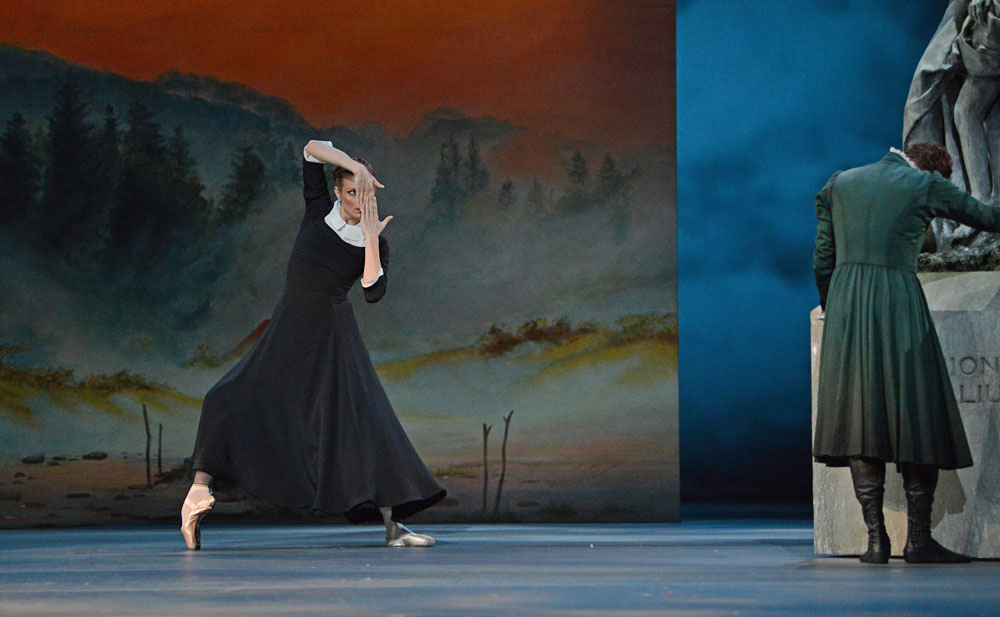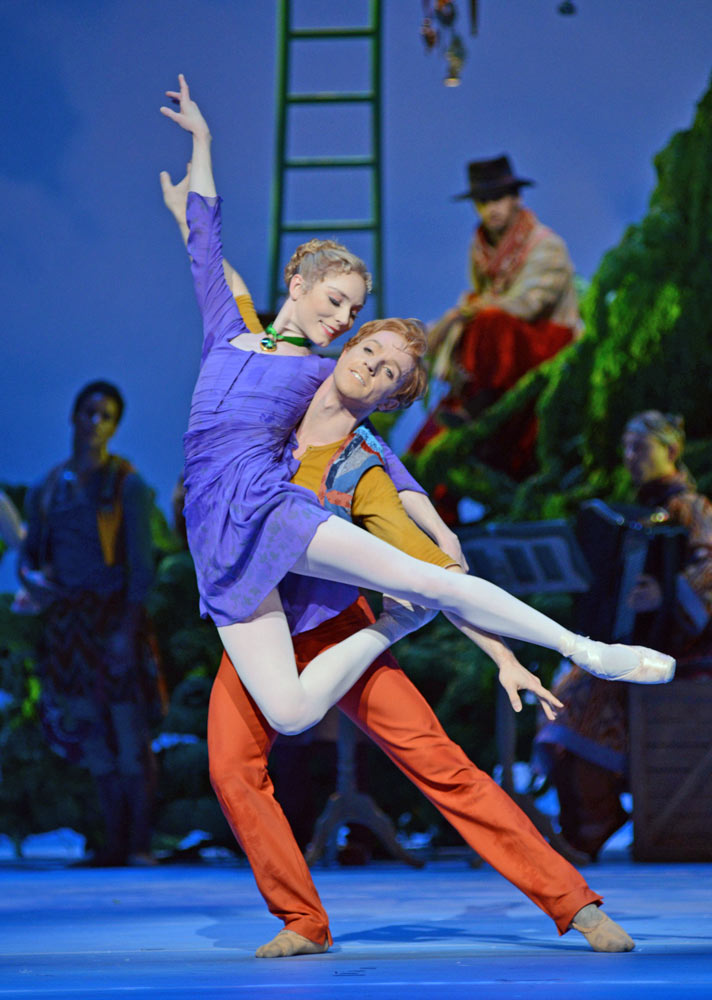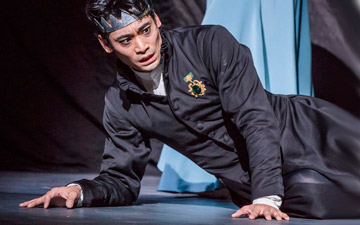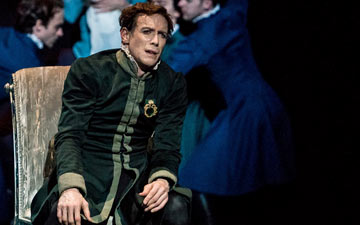
© Dave Morgan, courtesy the Royal Opera House. (Click image for larger version)
The Royal Ballet
The Winter’s Tale
London, Royal Opera House
10 April 2014
Gallery of pictures by Dave Morgan
www.roh.org.uk
Shakespeare’s 450th anniversary is an ideal pretext for a new ballet based on one of his plays – and why not The Winter’s Tale? Every story ballet could do with a mad king, a shipwreck, a man-eating bear, a lost royal child miraculously restored, and lots of festive opportunities for dancing.
When Nicholas Hytner suggested The Winter’s Tale to Christopher Wheeldon, he said that ballet could probably deal with the disjunctions in Shakespeare’s ‘problem’ play better than most drama productions. Old ballets are full of absurdities, taking time out from tangled plots to indulge in magical scenes that keep the corps de ballet busy. The Sleeping Beauty, for example, jumps forward a hundred years from Act I to the vision of 18 year-old Aurora surrounded by dryads in Act II. So, in the ballet version of The Winter’s Tale, there’s really no need to account for the abrupt change of scene from the Sicilian court in Act I to to the Bohemian rhapsodies in Act II some 16 years later. Shakespeare introduced an unwieldy figure of Time to explain the time change to his groundlings: ballet-goers can take it for granted.

© Dave Morgan, courtesy the Royal Opera House. (Click image for larger version)
Wheeldon is rather too painstaking in telling the story he has adapted from the wordy original. The Winter’s Tale may not be as familiar as Romeo and Juliet, but the gist of the plot is perfectly clear. By illustrating characters’ predicaments with graphic statuary and by spelling out each sea voyage with a departure or arrival via a gangplank and a projection of a ship, he makes his ballet seem old-fashioned. He could trust his audience to be quicker on the uptake: films have trained us to accept jump cuts and flashbacks.
That said, his staging very effectively brings out parallels between the two kings, Leontes of Sicilia and Polixenes of Bohemia, and their relationships with their children and advisors. A prologue shows the closeness between the kings as young princelings who will have to bear the weight of crowns and adult responsibilities. Their outfits are colour-coded, while courtiers are dressed in black as a semi-abstract chorus. Their ritualistic movements indicate that this story – ‘a sad tale’s best for winter’, says Leontes’ little son, Mamillius – is a nature myth. A sacrifice will have to be made before spring can arrive. A tree projected on the backcloth loses its leaves.
Bob Crowley’s designs are an eclectic combination of his own work and that of others: eerie paintings by Caspar David Friedrich (1774-1840), pseudo-classical and ‘realistic’ statues, projected images and solid constructions, including a sturdy Tree of Life in Act II. Costumes vary from semi-fascist uniforms for court soldiery to ethnic peasantry by way of simple gowns for the leading women. This is a timeless tale.

© Dave Morgan, courtesy the Royal Opera House. (Click image for larger version)
By the start of Act I, Leontes’ queen, Hermione (Lauren Cuthbertson), who was swung lithely in the prologue between the two kings, her husband Leontes (Edward Watson) and Polixenes (Federico Bonelli) now has a nine-month baby bump. Though there have been a few pregnant ladies in ballets (Stephanie in Mayerling, Isadora), they haven’t danced full out, as Hermione does. Frankly, it’s ludicrously implausible. She’s warned not to, like Giselle with her heart condition, but she goes ahead anyway. The bump is patently prosthetic in balletic lifts. It is, of course, the reason for Leontes’ paroxysms of jealousy. There is a frozen moment when his hand on her swollen belly tautens into a claw, as he is stricken with the convinction that the unborn child is not his but Polixenes’.
Watson goes into full-blown psychotic mode, a creature gnawing his own entrails, tearing his limbs apart in frantic leaps, scrabbling like a spider. He is the cause of the disasters to come in his court, so he is given lots of wrenching choreography, as well as being confronted by a sequence of statues confirming his worst suspicions: they are bad art, a crude prefiguring of the living statue at the end of the play and ballet. MacMillan’s Mayerling is consciously echoed in a scene in Hermione’s boudoir with her ladies-in-waiting, overseen by sinister guards. Leontes enters, transformed into a mad tyrant, capable of abusing her and his new-born daughter, and bringing about the death of his heir, Mamillius.

© Dave Morgan, courtesy the Royal Opera House. (Click image for larger version)
There’s a lot to cram into the 50 minutes of Act I. Hermione on trial has a long, poignant solo to protest her innocence, in a role that ranges from marital love to plaintive confusion, righteous anger and distress at the loss of her children. When she appears to die, her staunchest supporter, Paulina (Zenaida Yanowsky), forces Leontes to accept responsibility for what he has done. She’s even more intimidating than the prosecutor in the Oscar Pistorius trial. But she is also a loving wife, bidding farewell to her husband, Antigonus (Bennet Gartside), as he sails away with the rejected baby princess.
In a coda to Act I, Antigonus survives a storm and abandons the child on the imaginary shore of Bohemia, perilously close to waves of silk that metamorphose into the beast that does for him. Enter a shepherd and his young son who recover the baby – watch its arms move – and the treasure left with it.

© Dave Morgan, courtesy the Royal Opera House. (Click image for larger version)
In Act II Wheeldon and his collaborators revel in what ballet can do best. Beneath a magical tree in spring, young lovers frolic, peasants folk-dance and aristocrats disguise themselves ineffectively. There’s even an onstage band accompanying the festivities. Sarah Lamb as Perdita is clearly no shepherd’s daughter: dressed in purple to resemble Hermione, she’s fine-boned and fine-mannered. Her suitor, Steven McRae as Prince Florizel, is more boisterous than she is and a tad too pleased with himself in show-off solos.
A sparkier, better-matched pair are Valentino Zucchetti as the shepherd’s son and Beatriz Stix-Brunell as his girlfriend. They light up the already bright stage with verve and wit. He is no fool, this young shepherd (unlike Shakespeare’s clown), whose affectionate relationship with his father (Gary Avis) is happier than that of Florizel and Polixenes.

© Dave Morgan, courtesy the Royal Opera House. (Click image for larger version)
Joby Talbot has provided masses of merry music for Act II to counter the dramatic crises of Act I. He and Wheeldon have invented non-specific ethnic folk dances of different kinds, as well as a lyrical pas de deux for Perdita and Florizel. Bohemia has a self-contained sound-world of its own, like that of a vision scene, though as Talbot points out in a programme interview, Perdita shares her mother’s motif. The music knows more than the characters on stage.
Act III returns to wintry Sicilia and some truly bad taste memorial statues. Revelations that occur offstage in the play are shown in full, with the most moving moment Paulina’s recognition of the necklace Perdita is wearing. That which was lost has been restored; spring can finally arrive in Sicilia; the two kings are reconciled through their children; everybody rejoices in new outfits and new dances, to music that combines themes from the previous acts.

© Dave Morgan, courtesy the Royal Opera House. (Click image for larger version)
This would be the usual ending for a ballet, except that Hermione remains to be dealt with – the high point of Shakespeare’s play. Paulina semaphores that another journey needs to be taken to marvel at a marble tribute to Hermione and Mamillius. Only one of the linked figures moves, as Hermione joins Leontes in a back-to-back pas de deux like that of Orpheus and Eurydice. She then breaks away to express her forgiveness of him in a sequence of eloquent arabesques before realising that her daughter has returned. Cue pink clouds and pealing bells for the women, but a diminuendo ending for Leontes, reproved by the monstrous statue of his dead heir.
Wheeldon has honed his craft in making a story ballet, much better constructed than his Alice’s Adventures in Wonderland. His core characters account for themselves in revealing solos and his pas de deux are no longer over-ingenious. There are charmingly innocent lifts for couples in Act II, contrasted with the contortions of Leontes’ brutal treatment of pregnant Hermione. The choreography for ensembles in Sicilia and Bohemia is also adroitly contrasted, though flexed feet in pointe shoes is too easy a resort for folksiness.

© Dave Morgan, courtesy the Royal Opera House. (Click image for larger version)
What Wheeldon hasn’t done is challenge the company’s dancers or audiences. Hytner was right in that Shakespeare’s play can indeed work as a ballet, though the knotted language is what makes it worth experiencing in the theatre. Wheeldon has accomplished a perfectly attractive ballet (and let’s be appreciative of that, after McGregor’s Raven Girl) without advancing the narrative genre in any way. His approach is closer to David Bintley than Kenneth MacMillan – for which some ballet-goers may be grateful. I doubt that The Winter’s Tale will prove a game-changer for him or the company, which knows very well how to bring off a ballet with rewarding roles and fun festivities. Will another cast bring fresh insights? Will cinema-goers be enthralled when The Winter’s Tale is relayed live? We wait to find out.

















You must be logged in to post a comment.